MARKET OVERVIEW
The Global Electric Scooter and Motorcycle market and its industry form a dynamic section of the automobile sector, engaged in designing, manufacturing, and distributing two-wheeled electric vehicles. These vehicles work on electric powertrains and rely on batteries as their principal source of energy. As concerns for the environment and energy efficiency become the new norm worldwide, this market is likely to redefine personal and commercial mobility options in the years to come.
Electric scooters and motorcycles cater to a spectrum of needs, ranging from short, urban commutes to more considerable travel needs. The market addresses models in three segments, targeted for personal, logistics applications, and shared use. In such a context, the innovations and improvements seen with battery technology, along with increased investment in charging infrastructure, point toward a balance of sustainable with practicality and affordability as the manufacturing strategies in the near term.
That shall witness tremendous innovations, where market players around several geographies undertake efforts in refining the vehicle efficiency, improving distances, and optimizing the expense structures. Influenced by increasingly more demanding requirements of environmentally sustainable options instead of the conventional fuel-powered vehicles having an internal combustion engine (ICE), the demand for electric scooters and motorbikes would become significant. Changing regulatory landscapes, the government policy support on electric mobility, and a rise in the need to reduce carbon footprint are likely to push up demand for this product. Therefore, an overall increase in demand for electric scooters and motorcycles will spur more research and development from the manufacturer’s end.
New players along with current participants have space in making the opportunity when the material, the design, and the digital system concerning this matures. In addition, smart functions such as navigation using GPS with smart phone-based connectivity and ride assistance will also impact consumer perceptions. Also, collaboration with manufacturers from other industries that deal with battery suppliers combined with the involvement of technology firms will ascertain further growth channels for efficient reliable two-wheelers in this category of e-ric.
The regional distinction in the demand pattern is expected to exist in the Global Electric Scooter and Motorcycle market, depending on the economic conditions, as well as the rate of infrastructure development and consumer preferences. In highly populated urban areas, there will be an emphasis on compact and light-weight electric scooters for low-cost mobility solutions in dense roads. Regions with high disposable income and vast geographical dimensions are more likely to incline towards performance-oriented electric motorcycles with higher distances traveled.
Looking ahead, sustainability will be the foundation of this market, focusing on reducing lifecycle emissions and minimizing environmental impact. Recycling initiatives for batteries and the use of renewable energy sources in production processes will become increasingly important. The market will also be shaped by the evolution of charging networks, as fast-charging technology and battery swapping systems gain traction.
The Global Electric Scooter and Motorcycle market will redefine the transportation landscape by offering eco-friendly alternatives to conventional vehicles. This industry will pave the way for a sustainable future, providing innovative mobility solutions for diverse consumer and commercial needs, as technology and infrastructure advance. The market will continue to attract significant investments, stimulate economic activity, and contribute to a greener world.
Global Electric Scooter and Motorcycle market is estimated to reach $15,950.67 Million by 2031; growing at a CAGR of 19.0% from 2024 to 2031.
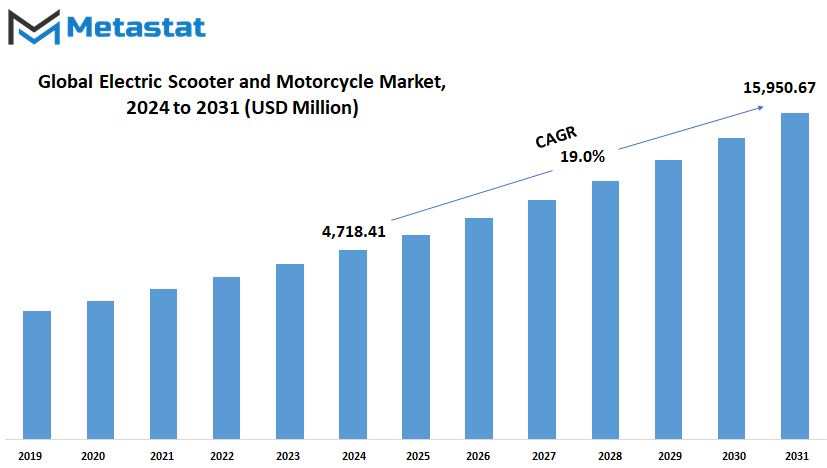
GROWTH FACTORS
The Global Electric Scooter and Motorcycle market is showing a strong trend of growth due to increasing utilization of electric vehicles as an efficient mode of transportation by the world's people and businesses. Growth in adoption of electric vehicles leads to growth in the Electric Scooter and Motorcycle market. The more people and businesses are realizing the environmental and cost advantages of switching from traditional gasoline-powered vehicles to electric models, the higher the demand for electric scooters and motorcycles. This is particularly evident in urban areas where there is an increased need for cleaner and more energy-efficient transportation solutions.
With the rising needs of electric scooters and motorcycles in the market, demand for charging stations that can function efficiently and properly is increasing significantly. Alongside the rising population of electric cars on roads comes the growing desire for more electric vehicle-friendly stations. This also involves advancements that technology brings across to counter all such issues in this world. One of the most exciting developments is the integration of software solutions with charging infrastructure and renewable energy sources. Such innovations enhance the efficiency of charging systems, allowing EV owners to recharge their vehicles faster and more conveniently. As a result, charging stations are becoming more accessible and efficient, helping further drive the growth of the electric scooter and motorcycle market.
Despite these positive factors, however, some challenges are still likely to slow the market's growth. Quite possibly, the highest hurdle is the cost of installing and maintaining charging infrastructure and software solutions – something that could well deter businesses and governments from heavily investing in widespread charging networks. Moreover, there is a lack of standardization and interoperability between different EV charging networks, leading to confusion in the minds of the users and limitations of the potential of the market. Inconsistencies in charging standards might also prevent an increase in the infrastructure of charging because it will be hard to build a commonly compatible network.
On the other hand, significant opportunities for growth exist in the near future. With the growth of smart city initiatives around the world, the demand for efficient charging systems will increase. Smart cities rely on the use of advanced technologies to run the urban system and infrastructure. Integration into the management systems of transportation and energy will enable developments with renewable sources of energy, thus making charging management more sustainable and efficient. This trend presents significant growth potential for the market, as businesses and governments seek to develop and implement charging solutions that align with their broader sustainability goals.
In conclusion, though there are huge challenges to be addressed, the global electric scooter and motorcycle market has immense promise. Going forward, the market will continue its forward trajectory with the increasing adoption of electric vehicles, technology, and the expansion of smart city initiatives. Ongoing strides in the efficiency of charging infrastructure coupled with increasing renewable energy shall provide a significant push for the growth of this market.
MARKET SEGMENTATION
By Product Type
The Global Electric Scooter and Motorcycle market is a market that shall experience high growth in the forthcoming years. For instance, once people get proper awareness about global environmental concerns and sustainable transports, the products are going to become immensely popular. This shift to EVs is part of a large movement away from carbon and fossil fuels. Advances in technology also provide the basis for this shift: manufacturers are coming up with new, more efficient, and even cheaper options in electric transportation.
Electric scooters and electric motorcycles classify the market in terms of product type. Due to their compact size and ease of navigation through heavy traffic, electric scooters have become a popular option in many cities. They are often considered a perfect mode of transportation for short commutes or urban travel. Their affordability, ease of use, and the rising number of shared electric scooter services make them an attractive option to younger consumers and city dwellers. Electric scooters are lightweight, and their recharging is at home. Hence, they become a great appliance for daily usage.
On the other hand, electric motorcycles are likely to gain more share in the future. They have more power compared to scooters and can take more distances with higher speed. Electric motorcycles appeal to a different group of consumers who are looking for an alternative to traditional gas-powered motorcycles. As battery technology improves, electric motorcycles will become more efficient and competitive with their gasoline-powered counterparts. Government incentives and subsidies to encourage the adoption of electric vehicles will further spur their growing popularity.
The Global Electric Scooter and Motorcycle market will, in the near future, evolve as more people opt for green transportation. It is likely that the key players in the market will focus on improving the battery life of their products, reduce charging times, and make them more accessible to a wider audience. It is evident that electric vehicles, such as scooters and motorcycles, will dominate urban mobility in the future. This shift will not only benefit the environment but also help to reduce urban congestion and create more sustainable cities. In conclusion, the Global Electric Scooter and Motorcycle market will grow and diversify as electric transportation options become more efficient, affordable, and widely accepted. Whether in the form of electric scooters or motorcycles, the future of transportation looks electric.
By Battery Type
The Global Electric Scooter and Motorcycle market is growing because people are increasingly becoming conscious of using environment-friendly transportation modes. There is a rising concern about climate change, and an increasing demand for sustainable mobility solutions. Therefore, electric scooters and motorcycles have become a promising alternative to the traditional gasoline-powered vehicles. Not only are they eco-friendly, but also they are cheaper and convenient modes of transport in crowded cities.
Perhaps, the biggest boost for the market of electric scooters and motorcycles comes from their tendency towards cleanliness. The Governments around the globe enforce stringent emissions controls and provide rewards to consumers switching towards pure electrics. Subsequently, they have started developing a better idea regarding electric scooters and motorcycles in general. For one, these mean low fuel bills; further, less or no maintenance as such; hence, very light impacts on the environment.
The Global Electric Scooter and Motorcycle market is primarily categorized into two major types: Lead-Acid Battery and Lithium-Ion Battery, both segmented based on the type of batteries. These types of batteries will have a respective advantage and drawback, and in the following years, their share in the market may be impacted due to those disadvantages and advantages. Lead-acid batteries are conventionally used for electric vehicles since they have lower costs and ensure reliable performance.
This means that they are relatively heavier and have a shorter shelf life compared to the lithium-ion batteries. The need for electric scooters and motorcycles is increasing; therefore, challenges related to lead-acid batteries are becoming very pronounced. Although they can still be used in entry-level electric vehicles, they will be less in demand as the more efficient and longer-lasting types gain popularity.
Whereas lithium-ion batteries are becoming lighter, are of higher energy density, and last longer compared to the previous type, many manufacturers are now switching towards the lithium-ion types. Although these ones are more expensive, the advantages they provide, such as faster recharging, longer traveling distances, and quicker performance, are forcing the Global Electric Scooter and Motorcycle market to shift its preference in battery types. As battery technology continues to advance, it is likely that lithium-ion batteries will dominate the market in the near future.
The market for electric scooters and motorcycles will be on the growth path with improvement in battery technologies. This would further drive adoption. Increasing attention to sustainability and reduction of carbon footprints would only speed up the demand for electric two-wheelers, particularly in urban areas where traffic congestion and pollution are major concerns. The shift to lithium-ion batteries will be one of the key factors to meet the increasing expectations of consumers for performance, cost-effectiveness, and environmental responsibility.
By Technology Type
The Global Electric Scooter and Motorcycle market is significantly growing as consumer and business perceptions shift towards alternative, more ecologically friendly sources of transportation. With the impact on the environment, increasing costs of fuel and the need to have cleaner air, the number of electric scooter and motorcycle seekers has increased manyfold. Given the technological advancements going on, this market is due to continue into the future propelled by government initiatives for clean energy and consumer realization of the convenience of electric transport.
Technology is one of the most critical aspects of the Global Electric Scooter and Motorcycle market. As the world shifts to greener solutions, technology opens the way to more efficient and reliable electric transportation. The market is divided into various technology types, with two significant categories: Plug-in and Battery. These technologies are vital to the development and success of electric two-wheelers.
The Plug-in refers to electric scooters and motorcycles in which the means of charging has to be supplemented through charging stations or home chargers to allow recharging to recharge the electric batteries. Due to the advancement of infrastructure and improvement of power, the sale of plug-in electric scooters and motorcycles should continue to thrive. In due course, this technology may become more advanced with quicker charging abilities and more easily accessible charging stations, making it even more attractive to consumers.
The other significant area in the Global Electric Scooter and Motorcycle market is battery technology. The electric scooters and motorcycles are generally considered more eco-friendly since they run on batteries. However, some of the models incorporate more advanced battery systems to improve the range and performance of the vehicle. With the advancement in battery technology, these vehicles will be able to travel further on a single charge. Innovations such as lighter, faster charging, and longer-lasting batteries are expected to improve the attractiveness of electric two-wheelers. It is through battery technology that the electric scooter and motorcycle will compete better with gasoline-powered alternatives.
With forward-looking vision, the Global Electric Scooter and Motorcycle market is likely to keep growing with a larger number of consumers looking to find alternatives in the future that can substitute their traditional vehicles. The growing trends in battery technology and the infrastructure of charging, along with rising environmental concerns, will further encourage consumers to take up electric scooters and motorcycles as a possible, efficient mode of transportation for a greener future.
By End-use
Electric scooter and motorcycle global market is indeed growing rapidly because of a multitude of factors which are propelling it. More and more, the world has been facing increased concern over climatic change and environmental sustainability; electric vehicles, in general, are becoming increasingly considered as eco-friendly alternatives over traditional gasoline-fueled models. Of the electric vehicles, electric scooters and motorcycles have become very popular due to efficiency, lower operation costs, and a positive environment. The market for such vehicles will only continue growing in the future. Improvement in technology, consumer behavior change, and push from the government through green transportation policies will also boost growth in the market.
The global electric scooter and motorcycle market should be divided by how it is classified based on its end-use. The two primary categories in this market are personal and commercial use, each with its own unique set of drivers and challenges. For personal use, many individuals are opting for electric scooters and motorcycles as a convenient and cost-effective means of transportation. These vehicles are particularly attractive to urban dwellers, as they provide an efficient way to navigate through congested city streets, while also offering the advantage of lower maintenance costs compared to traditional motorbikes. Additionally, the quiet operation of electric scooters and motorcycles, combined with zero emissions, makes them an attractive choice for environmentally conscious consumers.
Commercial use of electric scooters and motorcycles is also gaining momentum. Electric vehicles are being increasingly adopted by businesses in the delivery sector due to their ability to navigate through crowded areas, reduce fuel costs, and lower carbon footprints. The growth of e-commerce and the demand for faster, more sustainable delivery methods is expected to fuel this segment's growth in the coming years. Furthermore, governments worldwide are putting in place regulations and incentives that encourage companies to switch to electric vehicles, making commercial electric scooters and motorcycles a viable and attractive option for businesses.
The global electric scooter and motorcycle market will continue to evolve with both personal and commercial segments. Improvements in battery technology, charging infrastructure, and vehicle design will make electric scooters and motorcycles more accessible, efficient, and affordable for consumers. Cities will continue to push for greener transportation solutions, and demand for these vehicles will only increase, making the global electric scooter and motorcycle market a promising future.
|
Forecast Period |
2024-2031 |
|
Market Size in 2024 |
$4,718.41 million |
|
Market Size by 2031 |
$15,950.67 Million |
|
Growth Rate from 2024 to 2031 |
19.0% |
|
Base Year |
2022 |
|
Regions Covered |
North America, Europe, Asia-Pacific Green, South America, Middle East & Africa |
REGIONAL ANALYSIS
The global electric scooter and motorcycle market has been growing gradually, and the growth is likely to be continued as many regions of the world are now taking steps towards sustainability and alternate transport. This market is majorly driven by the increased adoption of electric vehicles (EVs) in light of environmental impact and the demand for energy-efficient, cost-effective transportation. Looking deeper into regional trends and patterns for the electric scooter and motorcycle markets reveals differences by area.
Growth is projected in North America, with especially large increases likely to be felt in the United States, Canada, and Mexico. The three North American nations are likely to be significant areas for increased spending on clean energy projects and on solutions to increase mobility within the city limits, particularly electric scooters and motorcycles. Government incentives, in the form of tax rebates and grants, along with improvement in charging infrastructure, will boost the demand for these green vehicles. Furthermore, the region's focus on relieving congestion in cities such as Los Angeles and New York will prompt the consumers to opt for electric scooters as an easy and environmentally friendly mode of transportation for distances less than two kilometers.
Electric scooters and motorcycles are gaining popularity in Europe, from the UK and Germany to France and Italy, among other countries. It is setting ambitious targets for carbon emissions and promoting green technologies. As European cities continue to grow denser and mobility in the city becomes harder, electric scooters and motorcycles will provide an efficient solution for the residents who need alternative transportation from the traditional mode of transportation. Additionally, most European countries are adopting strict environmental regulations that will push both the manufacturers and the consumers to shift to electric vehicles in the coming years.
Asia-Pacific is the biggest player in the global electric scooter and motorcycle market. Countries such as India, China, Japan, and South Korea dominate the markets in this region. China dominates this region because of its high manufacturing base and strong demand for electric two-wheelers. Continued support through subsidies and pushing for greater adoption of EVs by the government will make China a major market for electric scooters and motorcycles. In the case of India, its population and rapid urbanization will force the country to look for cost-effective and green modes of transport in the years to come. Technological developments and the changing trend toward sustainability will also speed up growth in Japan and South Korea.
Electric vehicles are likely to gain significant traction in South America, especially in Brazil and Argentina. The market is not yet matured, but the greater population's interest in electric scooters and motorcycles as a really practical method to fight air pollution and the fragmentation from fossil fuel will propel more government policies and incentives that build the growth of electric mobility.
Electric scooters and motorcycles are also forecasted to be a growing market in the Middle East and Africa, albeit slowly. The market demand will rise in the urban areas of GCC countries, Egypt, and South Africa. Yet the adoption pace may differ as this depends upon infrastructure availability, the local policy regarding the environment, and how much the region is ready for such green technology products. Governments throughout the region will be interested in diversified economies and sustainable development, but it is here that electric mobility is going to find a major place in transport infrastructure.
The global electric scooter and motorcycle market will continue to evolve in the future, with different regions offering unique opportunities and challenges. The market is expected to transform the way people travel across the world, with technological advancements, supportive government policies, and growing consumer awareness.
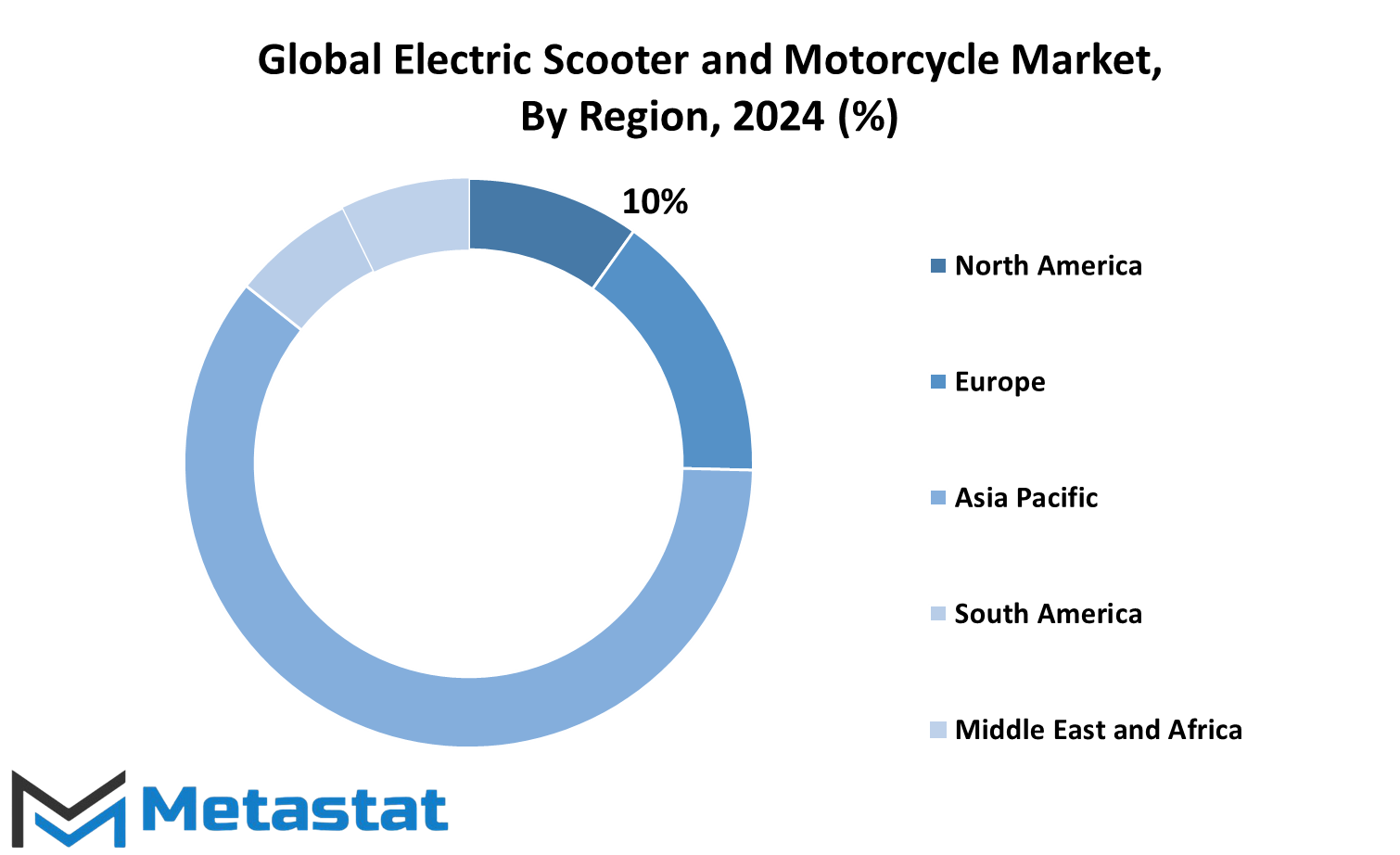
COMPETITIVE PLAYERS
The global electric scooter and motorcycle market has developed exponentially in the recent past, supported by the rapidly growing need for sustainable, environment-friendly transportation. As the world shifts toward decreasing carbon footprints and promoting clean energy solutions, the market will likely experience exponential growth in the coming years. Several companies drive innovation in this space, working tirelessly to meet consumer demand for electric two-wheelers that are not only efficient but also affordable and stylish.
One of the leading companies is Honda Motor Co., Ltd., with a well-known brand that has increased its participation in the electric scooter and motorcycle market. Known for its better engineering and innovative designs, Honda is expected to continue to extend the limits set by electric scooters and motorcycles. Similarly, Yamaha Motor Co., Ltd. has also significantly improved in the electric vehicle market. The company uses advanced technology in its electric two-wheelers to enhance performance and increase the battery life of electric vehicles. Bajaj Auto Ltd. has made waves in the electric vehicle arena in India. Bajaj's electric scooters have garnered attention not only in India but also internationally.
Yadea Technology Group Co., Ltd. is another player from China making waves across the globe, thanks to its long list of electric scooters. The company is expanding into other international markets as well, with affordable high-performance options for environmentally conscious commuters. Another notable Indian manufacturer, TVS Motor Company, has made its presence felt in electric two-wheelers, especially in the form of the TVS iQube, which won the hearts of customers through style and range.
Ather Energy, an Indian electric scooter start-up, is also getting much attention for the innovative approach of electric mobility, which focuses on smart, connected features. Okinawa Autotech Pvt. Ltd. has risen to become among the leading scooter manufacturers in electric scooters by India, diversifying its variety of products tailored to meet many customer needs. Zero Motorcycles, Inc has been known in the world market as making products for a very high-end clientele in high performance electric motorcycles while Ola Electric and newer participants in this highly competitive segment would bring on sharp technologies coupled with aggressive price mechanisms to knock industry incumbents NIU Technologies in smart scooters offering apps-based connectivity to receive diagnostics is helping them become hugely popular amongst very tech-adopting users.
KYMCO of Taiwan has used its electric scooters to conquer the world; Vmoto Limited, on the other hand, is doing great in Australia, with stylish and futuristic designs. Gogoro, Taiwanese, has concentrated on battery swapping, which gives the user access to a fast-swapped used battery for one that is new and fully charged. This innovation will be vital in the near future of this market, which is concerned with the lack of charging infrastructure.
Other major players include Torrot Electric Europa S.A., BMW AG (BMW Motorrad), and Piaggio & C. SpA, which are heavily investing in research and development for innovative electric motorcycles. With such companies introducing new and better products, the global electric scooter and motorcycle market will experience remarkable growth, and the competition among these key players will further spur innovation in technology and design. Eventually, the future of this market will be defined by the rising need for clean and efficient transportation solutions, and these companies will work to satisfy ever-growing needs around the world.
Electric Scooter and Motorcycle Market Key Segments:
By Product Type
- Electric Scooters
- Electric Motorcycles
By Battery Type
- Lead-Acid Battery
- Lithium-Ion Battery
By Technology Type
- Plug-in
- Battery
By End-use
- Personal
- Commercial
Key Global Electric Scooter and Motorcycle Industry Players
- Honda Motor Co., Ltd.
- Yamaha Motor Co., Ltd.
- Bajaj Auto Ltd.
- Yadea Technology Group Co., Ltd.
- TVS Motor Company
- Ather Energy
- Okinawa Autotech Pvt. Ltd.
- Zero Motorcycles, Inc.
- Ola Electric
- NIU Technologies
- KYMCO (Kwang Yang Motor Co.)
- Vmoto Limited
- Gogoro
- Torrot Electric Europa S.A.
- BMW AG (BMW Motorrad)
- Piaggio & C. SpA
WHAT REPORT PROVIDES
- Full in-depth analysis of the parent Industry
- Important changes in market and its dynamics
- Segmentation details of the market
- Former, on-going, and projected market analysis in terms of volume and value
- Assessment of niche industry developments
- Market share analysis
- Key strategies of major players
- Emerging segments and regional growth potential



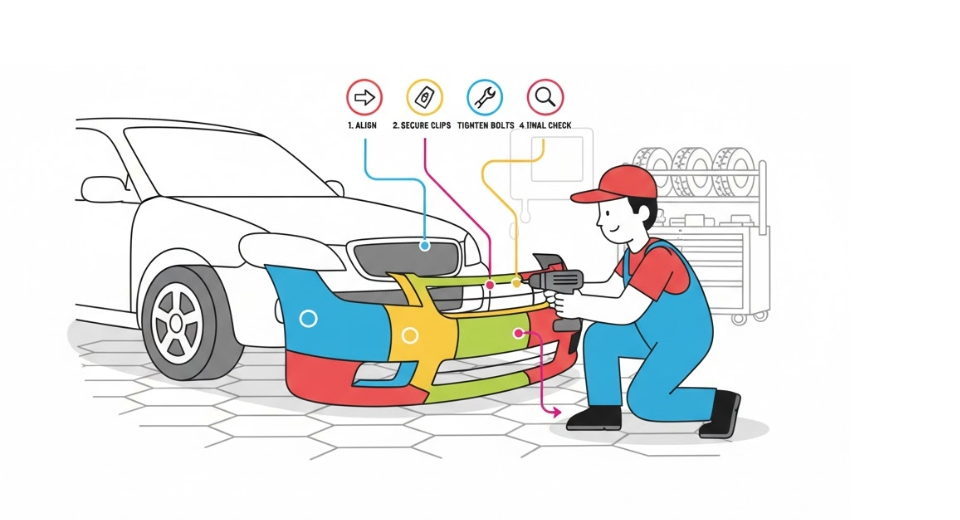
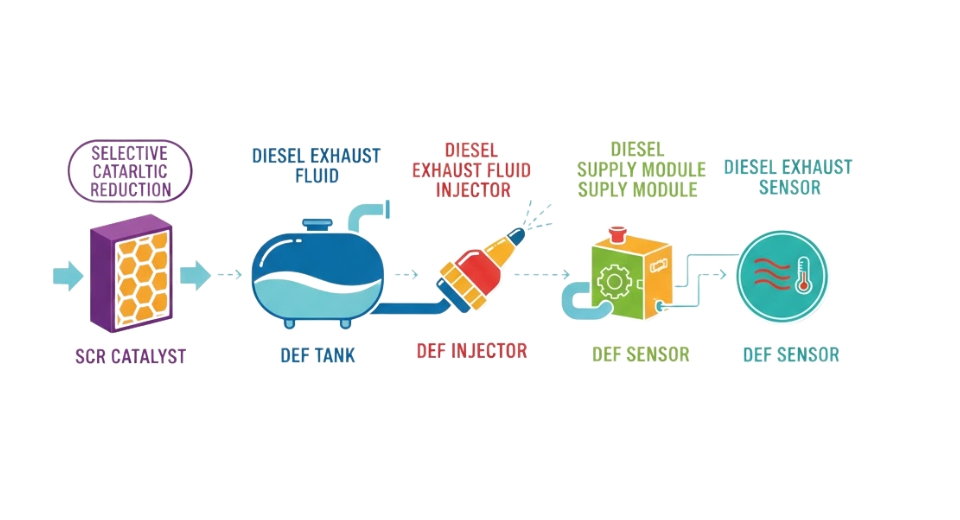
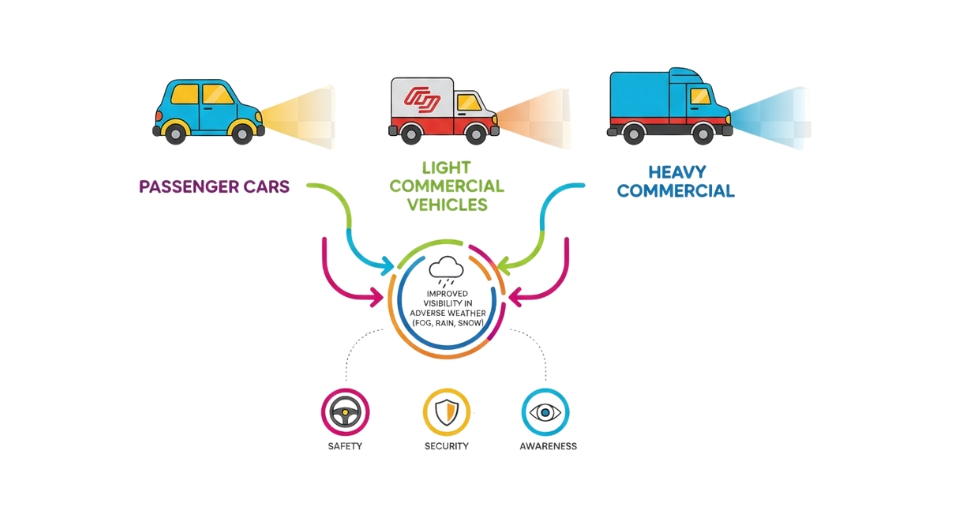


 US: +1 3023308252
US: +1 3023308252






